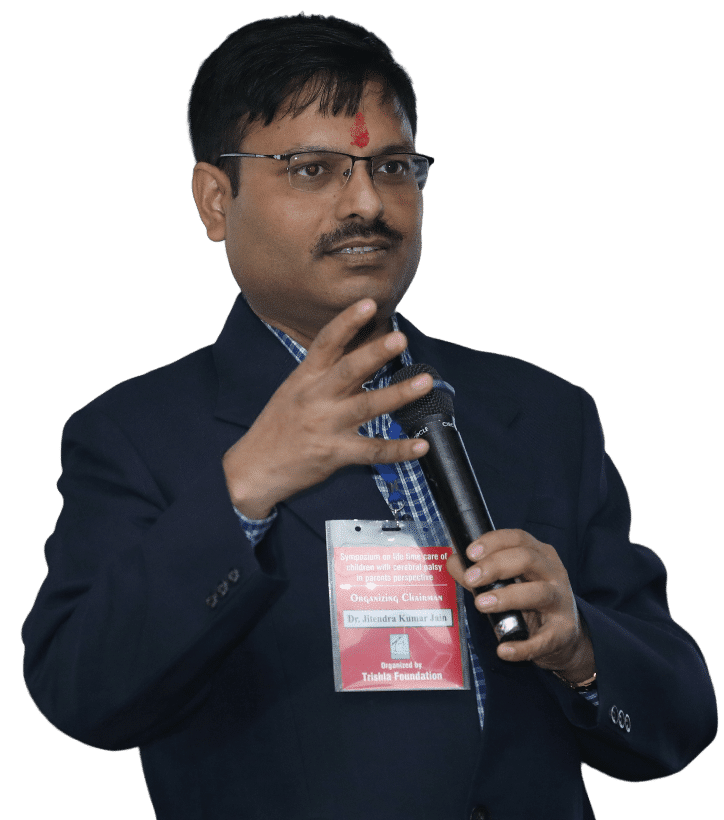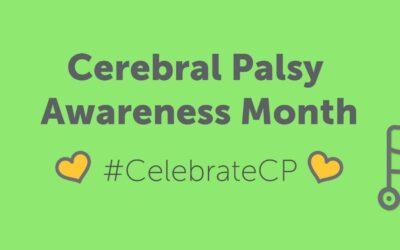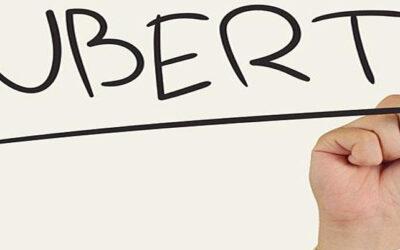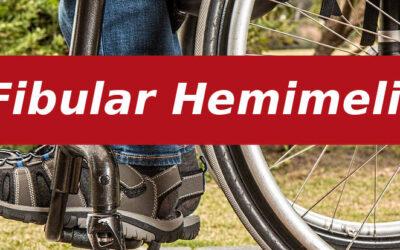Frequently Asked Questions About Cerebral Palsy In English
Question 1: What is cerebral palsy?
Answer: Cerebral palsy is not a disease but is a group of neuro-motor disorder which comprises disorder in movement and posture along with other associated medical problems like epilepsy (40%), intellectual deficit (30%), problem in speech (40%), hearing (20%), vision(30%) & sensation (40%), cognition, communication and perception. It is lifelong condition. Disability can be static, progressive or regressive based on environmental factors and medical measure taken.
Question 2: How it develops?
Answer: It is caused by non-progressive defect in immature & developing brain by any insult from the prenatal period to 2.5 years of postnatal period.
Question 3: What are the causes of brain Insult?
Answer: This insult can occur because of intrauterine infection, genetic factors, maternal hypothyroid, toxic drugs to mother, encephalitis, birth asphyxia, hyperbilirunemia, trauma to brain, etc. Infant born with very low birth weight (<1.5 kg) & very pre term baby < 32 week & second child of twins are at the highest risk for development of cerebral palsy. But in most of the cases exact causes are unknown. Multiple factor including genetic causes is most important factor which causes high risk for developing cerebral palsy.
Question 4: Does severity of problem in cerebral palsy remains constant?
Answer: Brain insult in cerebral palsy remains constant but severity of physical disability can remain constant, decrease or increase. Progression is based on environment/ time of intervention and quality of medical care given to child.
Question 5: How we can identify it?
Answer: If Infant born with the history of any high risk factor like low birth wt, very pre term baby, not showing normal development milestones like social mile, side turning, crawling, neck holding, dribbling of saliva, and abnormal response to stimuli, then there is probability that child can develop cerebral palsy. With increase in age if child is not progressing well as per their developmental milestone along with other associated medical problem then we can confirm the diagnosis of cerebral palsy. Diagnosis can be made even at the age of 6 months of age.
Question 6: What is the importance of early diagnosis in cerebral palsy?
Answer: Brain in early age till 2 years of age is in developing phase and has good chances of improvement. It occurs because of neuro-plasticity behaviour of developing brain. Early Intervention gives fairly good quality of independent life.
Question 7: What are Preventive methods?
Answer: It is true that cerebral palsy cannot be prevented fully but we can reduce the chance of getting cerebral palsy by reducing risk factors. We cannot prevent genetic or unknown causes, but good antenatal checkups, avoiding use of alcohol, cigarette, toxic drugs during pregnancy, and treatment of hypothyroidism with hospital based delivery & good care of neonates can prevent the development of cerebral palsy up-to some extent.
Question 8: How varieties of cerebral palsy affect treatment protocol?
Answer: Different varieties of cerebral palsy need different set of therapy protocol. Hemiplegic spastic cerebral palsy is mildest one and quadriplegic cerebral palsy affect severely to these children. Spastic cerebral palsy need advance physiotherapy along with botulinum toxin and some time surgical intervention. But dyskinetic & ataxic cerebral palsy doesn’t need surgery. These children need specialized relaxation exercises and activity oriented therapy.
Question 9 : What are the modalities of treatment?
Answer: Physiotherapy, advance Paediatric rehab technique, occupational therapy, speech therapy, yoga, training in ADL(activity of daily living), brace (AFO, FRO, SMO), walking aid, botulinum toxin, orthopaedic surgical intervention are few examples of treatment measure in cerebral palsy. Developmental Physiotherapy along with judicious use of light wt polypropylene brace & walking aid is the mainstay of treatment. Intervention in the form of botulinum toxin & surgery are needed to manage un-manageable consequences of spasticity & abnormal movement pattern.
Question 10 : Which type of therapy is most useful in cerebral palsy?
Answer: Child with CP can present in variety of manners depending upon type of movement disorder, severity of disability, extent of problem and associated medical problem. So each child need separate set of multimodal therapy program. Traditional therapy like stretching and finger, joint mobilization is of no use. Some time it can do harm to the child. So we should not use all these exercises in these children. We should focus on therapeutic modality which focuses on progression of physical and functional activity. Advance therapeutic techniques include Neurodevelopmental therapy (NDT), Sensory integration (SI), Mirror therapy, Yoga, CIMT, Strength training, sport, swimming etc. these exercises technique helps a lot.
Question 11 : What is the basic principle of NDT?
Answer: It is based on normal developmental pattern of child. In this system we utilise inhibition of abnormal reflexes, stimulation and facilitation of normal pattern of movement and activity in functional manner. In this technique abnormal reflexes are suppressed in such a manner so that it can be used in daily living activities.
Question 12 : What is the importance of physical activity in long-term goal in cerebral palsy?
Answer: Basic problem in cerebral palsy include muscle weakness, coordination, abnormal muscle tone, balance, selective motor control and sensory perception. Most of these factors persist for whole life. Spasticity and early muscle fatigue increase with increasing age, and weight so it is very important to continue with physiotherapy required at particular age and type, and also to keep weight under control. Once child achieves good milestone and ambulatory life at maturity then Gym and yoga helps a lot in these individual.
Question 13 : Can my child go to school along with continuing therapy session?
Answer: Yes education and therapy both have similar importance in overall progression of child with CP. It helps a lot in developing personality of child.
Question 14 : Up to what age we should continue therapy?
Answer: We should continue therapy until he/she becomes trained and self dependent in daily life activities. In elder children exercise must be done to increase their muscle power and maintain balance.
Question 15 : What is utility of brace & walking aid?
Answer: Braces are used to correct the abnormal posture of limb and to support joint and limb while walking, whereas walking aids help the children in balancing while walking. Sticks, elbow crutches and rollater are most commonly used walking aid in cerebral palsy.
Question 16 : What is the function of A.F.O.?
Answer: AFO helps in maintaining balance of foot, ankle joint by which child can have better control on legs.
Question: What other braces can be required for my child
A. The child may require FRO, SMO, Foot insert, gaitor, supinator splint along with AFO. Many modifications can be done in AFO according to need of child
Question 17 : Would my child require lifelong brace and assistive devices?
Answer: It depends upon many factors. Our aim is to give minimum support but we can’t avoid those in some circumstances
Question 18 : Does assistive devices have any effect on personality development?
Answer: No it don’t have any negative impact. But it helps in mingling with other person of society so that they have positive impact on personality.
Question 19 : What are the indications of botulinum toxin in cerebral palsy?
Answer: Indication of botulinum toxin is spastic & mixed cerebral palsy in young age (2-6 year age). Botulinum toxin doesn’t give good outcome in children once they develop fix contracture.
Question 20 : Can botulinum toxin injection give permanent relief from symptoms?
Answer: No. It is only to relieve spasticity for some times and helps to facilitate physiotherapy. It is only an aid to therapy. It also helps postponing the need, age and quantity of surgery. Time duration of effect can be enhanced by the judicious use of brace and good quality of therapy.
Question 21 : Is it cost effective?
Answer: Yes. In younger children it is very cost effective.
Question 22 : How much exercise is required after injection?
Answer: Intensive therapy is mandatory after botulinum toxin to get good functional outcome, to prolong effect of injection. Minimum 30 minutes exercise twice a day six days in week is required for good outcome. Intensive therapy is needed till child get good functional outcome. Then maintenance therapy should be continued.
Question 23 : How many chances are that, repeat injections of botulinum toxin injection would be required?
Answer: Effect of botulinum toxin lasts only for 4-5 months. But duration of effect can be enhanced with good rehab program and proper use of rehab. Repeat injection is required in sever spasticity but usually not before 1 year. Sometimes second injection may not be required at all.
Question 24 : What is the indication of orthopaedic Surgery in cerebral palsy?
Answer: Orthopaedic surgery is needed to correct the fix joint deformity, contracture, torsional deformity of bone and to replace the weakened muscle by tendon transfer. Surgical intervention is needed only in spastic and mixed cerebral palsy. If child don’t achieve any milestone then he should be managed with therapy program for initial few months then we plan for surgery.
Question 25 : How we make decision about surgical intervention in CP?
Answer: Selection of children with cerebral palsy for surgical intervention is made on the basis of fix joint deformity, contracture and bony deformity. Surgical intervention is needed only in spastic and mixed cerebral palsy. We make the decision on the basis of detail physical examination, gait analysis and reassessment under anaesthesia just before surgery.
Question 26 : What is the right age for surgery?
Answer: There is no ideal age of surgery but most of the time we defer surgery till the age of 7 years because gait matures from 6-7 year of age. But in certain conditions like early development of contracture, deformity and hip dislocation we go for surgical intervention even at early age.
Most of the time, if surgery is needed, then it is better to do between the age of 7-10 years for first time and at maturity (from 14-16 years age) for final correction.
Question 27 : What are the common orthopaedic surgery in cerebral palsy ?
Answer: A. Tenotomy: Cutting of tendon to release contracture. Very rare now days
B. Tendon lengthening: lengthening of tendon in fix length shortening of tendon (contracture). Less preferred now. Being done in only selected cases.
C : Arthrodesis of joint : Arthrodesis to stabilise the joint
D. Myofascial release: Release of superficial layer of fascia / aponurosis at muculotendinous junction / muscle itself .
D: Tendon transfer: Transfer of tendon to replace function of weakened muscle.
E : Osteotomy: Bony procedure to correct bony rotational, angular deformity and joint fix contracture
First three techniques are a part of routine orthopaedic surgery which was used initially in the management of cerebral palsy but today these are not used so commonly. Last three techniques are the advance and latest concept in orthopaedic management of children with spastic cerebral palsy
Question 28 : What is latest concept of surgery in cerebral palsy?
Answer: Single event multi level orthopaedic surgical intervention (SEMLOS/SEMLS)- in this maximum level of deformity is managed in single stage surgery. SEMLS doesn’t means that child will not need surgical intervention in future but it may be required in late age.
Question 29 : What is latest concept of surgery in cerebral palsy?
Answer: Single event multi level orthopaedic surgical intervention (SEMLOS/SEMLS)- in this maximum level of deformity is managed in single stage surgery. SEMLS doesn’t means that child will not need surgical intervention in future but it may be required in late age.
Lever arm restoration- Muscles in cerebral palsy are week so now days we don’t prefer to do surgery on muscle. Bony and joint deformity (Lever arm problem) in cerebral palsy put the muscle in bad condition so already weak muscle are not able perform well, so now days bony surgery including shortening and deformity correction osteotomy are given preference in place of muscle lengthening.
OSSCS- Whenever we need to lengthen muscle then myofascial ( tendinous sheath over muscle ) release is given preference over tendon lengthening.
Tendon transfer- Very week muscle at certain places is strengthened by Tendon transfer to replace function of weakened muscle. Tendon transfer is also being used to transfer shorten tendon to more proximal position so that function of muscle is saved.
All the surgical planning is done by repeat assessment including physical examination, gait analysis and pre-surgical assessment during surgery in operation theatre.
Question 30 : What is role of physical therapy after surgery?
Answer: Role of surgery is to correct the deformity. Functional improvement can only be achieved by physical therapy which should be intensive for initial few months followed by maintenance phase.
Question 31 : What is prognosis in cerebral palsy?
Answer: Prognosis is based on many factors like severity of brain damage, type of cerebral palsy, starting age of treatment, associated medical problem, treatment modality and dedication of parents and continuation of rehab measure. If child doesn’t achieve neck holding before the age of one year despite of good therapy then it is very much likely that child could have severe brain deficit and this child may not achieve independent ambulatory capability with all measures in later age.
Question 32 : What is quality of life in CP Children?
Answer: Quality of life & survival in Cerebral Palsy affected children with ambulatory capability with or without walking aid is roughly equal to normal population. They can be active, productive members of their communities. They can have jobs, live independently, marry, have children & retire. They can even excel in the activity given to them. Other children even with moderate disability can also be given good quality of life with modern medical care and latest rehab measure.
Question 33 : Why treatment of associated disability is very important in overall management of cerebral palsy?
Answer: Associated medical problem is one of the deciding factors in making prognosis and quality of life. It decides whole outcome so it is very important to treat all major associated medical issues along with physical disability. Period of major illness/ hospitalization in cerebral palsy occur because of associated medical problem, not by cerebral palsy itself.
Question 34 : How does external environment affect these children?
Answer: Interaction with external environment is very effective for these children. It helps in personality development.
Question 35 : How does interaction with other children affect my child?
Answer: This is a proven fact that interaction with other children, society and school environment is very helpful in their overall development.
Question 36 : Should we have another child if one child is affected with cerebral palsy?
Answer: Yes. If this child does not have any hereditary condition nor have any chance of it then having another child is very helpful in the development of this child.
Question 37 : How does special education help my child?
Answer: Special education trains child to use hand properly and also prepares them to go to normal schools.
Question 38 : Can CP children admitted to normal schools?
Answer: Yes. No school can deny admission of your child provided he/she is ready for that education.
Question 39 : What is the aim of treatment in these children?
Answer: Our aim is to reduce their disability and give them good quality of life. So that they can be integrated to the main stream of society and can use their functional & physical capability up-to their maximum potential.
Question 40 : Can nerve/ muscle stimulator technique completely cure my child?
Answer: No. These help your child in gaining strength of muscle. This technique is aid to physiotherapy.
Question 41 : Can electromagnetic therapy help my child?
Answer: No
Question 42 : What is the effect of acupuncture, acupressure, naturopathy, ayurvedic, homeopathic or allopathic medicine on my child?
Answer: These have very limited role that too in treatment of some associated problems.
Question 43 : What is the role of massage in CP?
Answer: Fast and deep massage is prohibited in all cases of cerebral palsy except Hypotonic one.
Question 44 : Can stem cell cure the child from cerebral palsy?
Answer: No. Till now it is not proven by any scientific study so far. Use of stem cell in cerebral palsy is still under research. International authorities have not approved the use of stem cell in clinical practice.
Question 45 : Can my child join main stream school along with therapy session ?
Answer: Yes. Exercise and education both should be part of daily activity. It helps a lot in overall development. First they would be able to mix up with their peers, second they would be able to intermingle with societal norms and therefore will become better adjusted to external environment.
Question 46 : Would the child require walking aid lifelong?
Answer: It depends on many things. Our aim of treatment is to make them self walker as much as possible be it with walking aid or fully independent.
Question 47 : Would these aids affect their personality?
Answer: These aids do not have negative impact on them but help them intermingle with society and increase their confidence in indoor and outdoor walking.
Question 48 :How does improvement in child’s physical ability affect his/her other activities?
Answer: It is observed that improvement in physical ability have tremendous impact in development of overall personality of the child.
Watch Our Success Stories
Watch Dr. Jitendra Kumar Jain treating cerebral palsy children with multiple therapies available.
Therapy such as physical therapy, occupational therapy, speech therapy, brace will help a lot in cerebral palsy treatment.
Subscribe To Our Youtube Channel
Page Medically Reviewed and Edited by
DR. Jitendra Kumar Jain
Dr. Jitendra Kumar Jain is a renowned name in the field of childhood physical disability & orthopedics problems in North India. He has been an MS Orthopedics, DNB Orthopedics, Pediatric orthopedic surgeon & cerebral palsy specialist for over 21 years.


Page Medically Reviewed and Edited by DR. JITENDRA KUMAR JAIN
Dr. Jitendra Kumar Jain is a renowned name in the field of childhood physical disability & orthopedics problems in North India. He has been an MS Orthopedics, DNB Orthopedics, Pediatric orthopedic surgeon & cerebral palsy specialist for over 21 years.
Testimonials
Make a Difference
Support Trishla Foundation's Life-Changing Work for Children with Cerebral Palsy!
Together, we can break barriers and empower children with cerebral palsy. With your generous contribution, Trishla Foundation can continue its vital work in providing therapies, education, and support to these incredible children. Help us create a brighter future by donating today!



